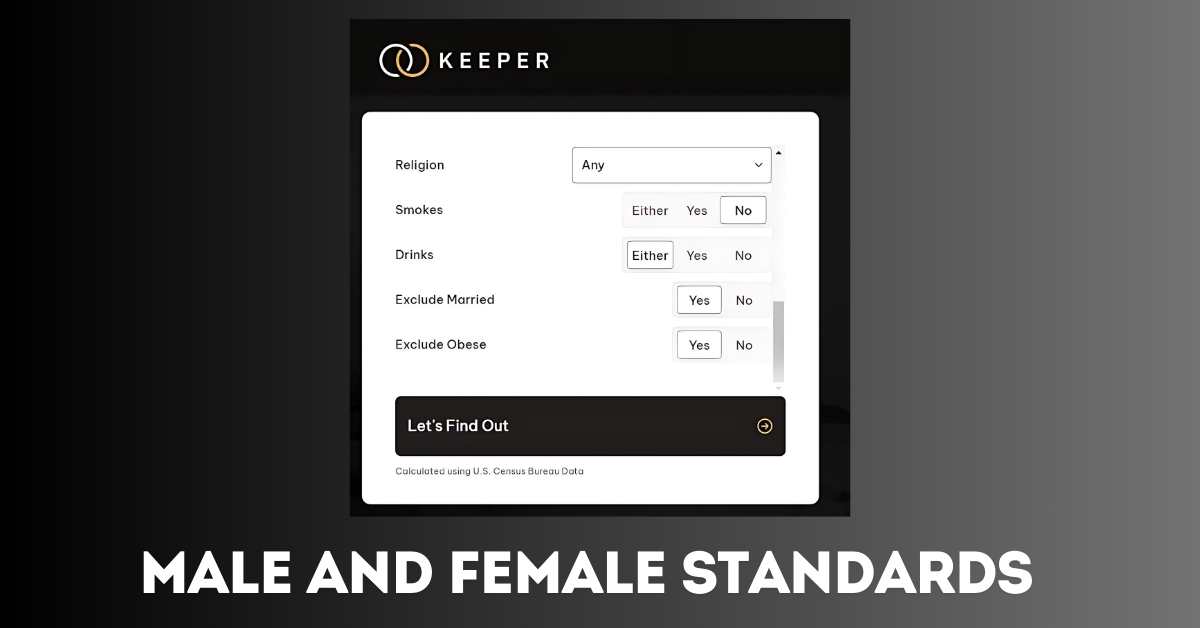In today’s digital age, finding a compatible partner can feel like navigating a complex maze of expectations, preferences, and societal standards. Enter the Male and Female Standards Calculator—a unique tool designed to help individuals understand the likelihood of finding their ideal partner based on specific criteria such as age, height, ethnicity, income, and more. This article provides an in-depth look at the Male and Female Standards Calculator, exploring its functionality, accuracy, data sources, and the implications of using such a tool in the search for love.
What is the Male and Female Standards Calculator?
An Overview of the Calculator
The Male and Female Standards Calculator is an online tool that enables users to enter their preferences for a potential partner and receive a statistical estimate of the likelihood of meeting someone who matches those criteria. Whether you’re curious about the chances of finding a partner within a certain age, height, or income range, this calculator offers a realistic snapshot of what you can expect in the dating scene.
How the Calculator Works
Users enter their desired partner’s characteristics, including age, height, ethnicity, education level, religion, income, and more. The calculator then cross-references this information with data from credible sources such as the US Census Bureau and the Centers for Disease Control and Prevention (CDC). Based on this data, the calculator generates a percentage that represents how common—or rare—your ideal partner is within the population.
The Purpose of the Standards Calculator
Bridging the Gap Between Expectations and Reality
One of the primary purposes of the Male and Female Standards Calculator is to bridge the gap between expectations and reality. Many individuals have specific preferences for a potential partner, but it’s not always clear whether these standards are realistic. The calculator offers a grounded perspective by showing users how many people in the population meet their criteria, helping them adjust their expectations if necessary.
Providing Clarity in the Search for Love
The search for a compatible partner can be overwhelming, especially with the vast array of options available today. The Standards Calculator provides clarity by giving users a data-driven estimate of their chances of finding someone who meets their standards. This clarity can be empowering, allowing users to make informed decisions about their dating life and focus their efforts more effectively.
Key Features of the Male and Female Standards Calculator
Customizable Criteria
One of the standout features of the Male and Female Standards Calculator is its ability to customize criteria. Users can specify a wide range of preferences, including:
- Age Range: Specify the age bracket of your ideal partner.
- Height: Input the minimum and maximum height you’re comfortable with.
- Ethnicity: Select the ethnic background(s) that are important to you.
- Income Level: Set the minimum income level you expect in a partner.
- Education Level: Choose the education level that aligns with your preferences.
- Religion: Filter potential partners based on religious affiliation.
This level of customization ensures that the calculator can accommodate the unique preferences of each user, making the results more relevant and personalized.
Data-Driven Results
The calculator’s results are based on data from reputable sources such as the US Census Bureau and the CDC. This reliance on empirical data ensures that the results are as accurate as possible, providing a realistic view of the dating landscape. Users can trust that the percentages generated by the calculator are grounded in real-world demographics and statistics.
User-Friendly Interface
The Male and Female Standards Calculator is designed to be user-friendly, with a straightforward interface that makes it easy to input preferences and understand results. The tool is accessible to anyone, regardless of their tech-savviness, and it provides clear, concise feedback without overwhelming the user with technical jargon.
How Accurate is the Standards Calculator?
The Role of Statistical Data
The accuracy of the Male and Female Standards Calculator largely depends on the quality and relevance of the statistical data it uses. By drawing on extensive datasets from the US Census Bureau and the CDC, the calculator offers a fairly accurate estimate of how many people meet the specified criteria. However, it’s important to remember that these statistics are generalized across the population and may not reflect individual circumstances or local variations.
Limitations of the Calculator
While the Standards Calculator provides valuable insights, it’s not without limitations. The tool can only offer a probability based on existing data and does not account for factors such as personal chemistry, individual attractiveness, or the effort one is willing to put into finding a partner. Additionally, the calculator is primarily designed for the US population, so its applicability in other countries or regions may be limited.
Understanding the Results
When using the Standards Calculator, it’s essential to interpret the results with a critical mind. A low percentage doesn’t mean finding a compatible partner is impossible, but it indicates that the specific combination of criteria is less common. On the other hand, a high percentage suggests that your standards align more with the general population, increasing your chances of finding a match.
The Data Behind the Calculator
Sources of Information
The data used by the Male and Female Standards Calculator comes from reliable sources, including:
- US Census Bureau: Provides demographic data, including age, ethnicity, income, and education levels across the US population.
- Centers for Disease Control and Prevention (CDC): Offers data on health-related factors, such as height and weight distributions within the population.
These sources are regularly updated, ensuring that the calculator’s results reflect current demographic trends.
How the Data is Used
The calculator cross-references user input with different datasets. It calculates the population percentage meeting the criteria. This helps users see how common their desired traits are. It also shows how rare they are in the broader dating pool.
Privacy and Data Security
One common concern with online tools is the security of personal information. The Male and Female Standards Calculator is designed with user privacy in mind. It does not store any personal information entered by users, ensuring that all data remains confidential. The tool operates anonymously, providing results without the need for sign-ups or personal data entry.
Practical Applications of the Standards Calculator
Setting Realistic Expectations
One of the most practical uses of the Male and Female Standards Calculator is in setting realistic expectations for dating. By learning how common certain traits are, users can adjust their standards if necessary, allowing them to approach dating with a more grounded mindset.
Enhancing Self-Awareness
The calculator also serves as a tool for self-reflection. By exploring the likelihood of finding a partner with specific traits, users can gain a better understanding of their own preferences and priorities. This self-awareness can lead to more informed decisions in both dating and personal development.
A Tool for Dating Strategy
For those serious about finding a partner, the Standards Calculator can be a useful part of a broader dating strategy. By identifying which traits are more common, users can focus their efforts on areas where success is more likely, improving their chances of finding a compatible match.
Ethical Considerations and Social Implications
The Impact of Setting Standards
While the Male and Female Standards Calculator is a helpful tool, it’s important to consider the ethical implications of setting strict standards in relationships. While it’s natural to have preferences, overly rigid standards can lead to missed opportunities and reinforce unrealistic expectations. It’s crucial to balance personal preferences with openness to unexpected connections.
The Risk of Superficiality
One potential downside of using a tool like the Standards Calculator is the risk of focusing too much on superficial traits. While factors like height, income, and education are important, they don’t necessarily determine compatibility or long-term relationship success. Users should be mindful of not letting the calculator’s results dictate their entire approach to dating.
Encouraging Inclusivity
The Standards Calculator can also be used to promote inclusivity by helping users recognize the diversity within the dating pool. By exploring various combinations of traits, users may become more open to potential partners they hadn’t previously considered. This encourages a more inclusive and flexible approach to dating.
Frequently Asked Questions About the Standards Calculator
Is the Standards Calculator Free to Use?
Yes, the Male and Female Standards Calculator is a free tool that anyone can use without needing to sign up or provide personal information.
Can the Calculator Help Me Find a Partner?
While the calculator provides insights into the likelihood of finding someone who meets your criteria, it does not directly help you find a partner. It’s a tool for self-assessment and expectation-setting rather than a matchmaking service.
How Accurate Are the Results?
The results are based on statistical data from credible sources, making them reasonably accurate. However, the calculator provides general estimates and cannot account for personal factors or local variations.
Is My Information Secure?
Yes, the Standards Calculator does not store any information entered by users, ensuring complete privacy and data security.
Can the Calculator Be Used Outside the US?
While the data is primarily based on the US population, the calculator can still offer general insights for users in other countries. However, the accuracy may be lower due to differences in demographics and population distribution.
Conclusion: Is the Male and Female Standards Calculator Worth Using?
A Valuable Tool for Self-Reflection
The Male and Female Standards Calculator is a valuable tool for anyone looking to gain clarity on their dating expectations. By offering a data-driven estimate of how common certain traits are in the population, the calculator helps users set realistic standards. It enables them to approach the dating scene with informed confidence.
Not a Definitive Guide
However, it’s important to remember that the calculator is not a definitive guide to finding love. While the calculator provides useful insights, it should be part of a broader approach to dating that blends data with personal experience. Ultimately, finding a compatible partner requires balancing realistic expectations, being open to new possibilities, and seeking deeper connections.
Final Thoughts
Whether you’re curious about your chances of meeting someone who matches your ideal criteria or just seeking a fun way to explore your dating preferences, the Male and Female Standards Calculator offers a unique and insightful experience. By combining data with personal preferences, it gives a grounded perspective on the dating landscape. This can help enhance your understanding and navigate it more effectively.
Read More: Trivise/ General









